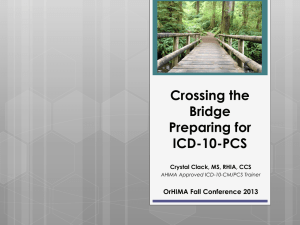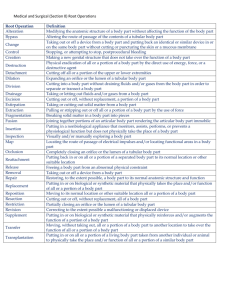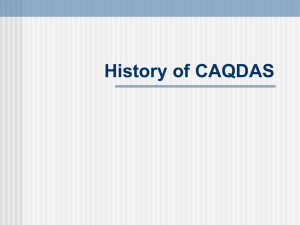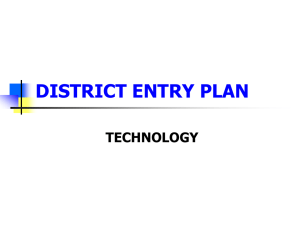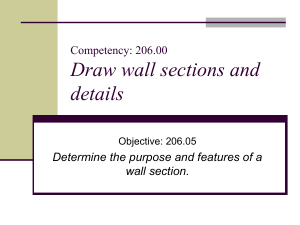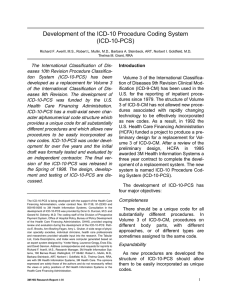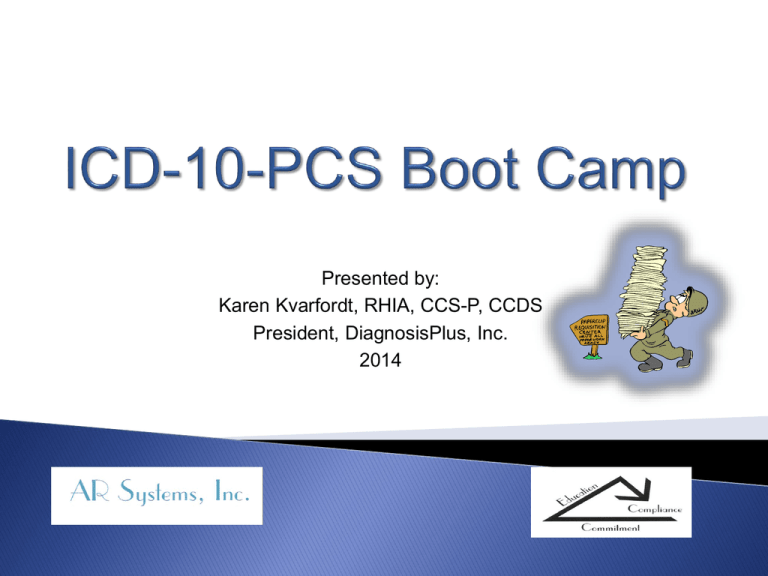
Presented by:
Karen Kvarfordt, RHIA, CCS-P, CCDS
President, DiagnosisPlus, Inc.
2014
Things
will never be the same once
we switch to ICD-10-PCS!
Complete overhaul of the procedure
classification system as we know it
today.
Tip! Refer to Appendix F: Character
Meanings – this will save you!
But don’t panic, it can be easily
mastered!
3
ICD-10-PCS codes include one digit for the
root operation that the physician performs.
Root operation is always the 3rd character
in the seven character code.
Start by reviewing the definitions of the
various root operations. If you learn the
root operations early, you’ll have a head
start on learning how to code in ICD-10PCS.
4
Always
look first in the Alphabetic
Index (will give you the first 3 or 4
characters) and then finish building
the procedure code in the Tables.
Key! You can’t jump around in the
tables. Need to go across to get your
procedure code!
5
CMS awarded the contract to 3M Health
Information Systems to develop a new
procedure coding system for ICD-10.
New system is intended to replace ICD9-CM Volume 3 for reporting hospital
inpatient procedures.
But what about the outpatient side?
6
Diagnostic
information is not included
in the code description.
A ‘not elsewhere classified’ option is
allowed for new devices and
substances.
All substantially different procedures
are defined.
7
A
general body part, approach, or
root operation can be used when the
level of specificity is not available in
the record or cannot otherwise be
obtained.
Should you query?
8
Body Part:
◦ Example: “Liver” is used when the specific liver lobe is not
identified.
Approach:
◦ “Open”, “Percutaneous” and “Via Natural or Artificial
Opening” are used when a more specific type of approach
is not documented and cannot otherwise be determined.
Root Operation:
◦ “Repair” is used when the procedure documentation does
NOT support a specific root operation and the information
cannot otherwise be obtained.
9
ICD-9-CM (Volume 3)
ICD-10-PCS
(Procedures)
(Procedures)
◦ Min. characters: 3
◦ Max. characters: 4
◦ Numeric format
(+ V code)
◦ Decimal point
◦ 3,000 procedure codes
◦
◦
◦
◦
◦
Min. characters: 7
Max. characters: 7
Alphanumeric format
No decimal point
71,918 procedure
codes
10
Section
Codes
Medical and Surgical**
61,896
Obstetrics
300
Placement
861
Administration
1,384
Measurement and Monitoring
339
Extracorporeal Assistance and
Performance
41
Extracorporeal Therapies
42
Osteopathic
100
Other Procedures
60
Chiropractic
90
Imaging
2,934
Nuclear Medicine
463
Radiation Oncology
1,939
Rehabilitation and Diagnostic Audiology
1,380
Mental Health
30
Substance Abuse Treatment
59
Total
71,918
11
Seven Character Alphanumeric Code
◦ All procedure codes will be seven
characters long
◦ “I” and “O” (letters) are never used
Why not?
34 possible values for each character
◦ Digits 0 – 9
◦ Letters A-H, J-N, P-Z
12
• Medical and Surgical
• Other Procedures
• Obstetrics
• Chiropractic
• Placement
• Imaging
• Administration
• Nuclear Medicine
• Measurement and
Monitoring
• Radiation Oncology
• Extracorporeal Assistance
and Performance
• Physical Rehabilitation and
Diagnostic Audiology
• Extracorporeal Therapies
• Mental Health
• Osteopathic
• Substance Abuse
Treatment
13
Each table contains four columns and
varying numbers of rows.
Column: Specifies the allowable values
for characters 4-7
Row: Specifies the valid combinations of
values
Building block concept!
14
15
Section: Identifies general type of procedure
Body System: Identifies general body system
Root Operation: Specifies objective of procedure
Body Part: Identifies specific part of body system on
which procedure is being performed
Approach: Technique used to reach the site of the
procedure
Device: Identifies devices that remain after procedure is
completed
Qualifier: Provides additional information about a
procedure, if necessary
16
Provides the first three or four characters of the
procedure code.
The tables must always be used to obtain the
remaining digits for the complete code.
No eponyms are included.
Tables are used to construct a complete and valid
code.
Only characters appearing on the table may be
used.
17
Medical and Surgical Section
18
1
2
3
4
Root
Operation
Section
5
6
Approach
Body
Body
System
Part
7
Qualifier
Device
19
1st character = Section
2nd character = Body System
3rd character = Root Operation
4th character = Body Part
5th character = Approach
6th character = Device
7th character = Qualifier
20
The
root operation is based on the
“objective or intent” of the procedure
not by the procedure name.
If multiple procedures as defined by
distinct objectives are performed,
then multiple ICD-10-PCS procedure
codes are assigned.
21
16
sections within ICD-10-PCS, the
largest being the Medical & Surgical
section.
Defines the general ‘type’ of
procedure, i.e., Med/Surg, OB, etc.
Medical and Surgical Section the first
character is always the number “0”.
22
Identifies the body system, which is the general
physiological system or anatomical region where
the procedure is performed.
Total of 31 body systems in ICD-10-PCS.
Some traditional categories are subdivided into
several body systems, for example:
Cardiovascular is subdivided into 5 body systems:
Heart and Great Vessels
Upper Arteries
Lower Arteries
Upper Veins
Lower Veins
23
Refer
to the ICD-10-PCS code book
for a complete listing of the body
systems (pg. 5).
24
Defines the “objective” or “intent” of doing the
procedure.
33 different root operation values
Each root operation identifies a precise
and distinct objective.
◦ This is the most difficult part of procedural
coding as the root operations may sound
familiar, but may mean different things.
◦ Most time will be spent here!
25
The root operations ‘excision’ and ‘resection’ will be
the most difficult to distinguish.
◦ Excision: Cutting out or off, without replacement a portion
of a body part
◦ Resection: Cutting out or off, without replacement, all of a
body part
These definitions look very similar, but are very
different as they involve a portion versus all of a
body part.
26
• Alteration
• Fragmentation
• Restriction
• Bypass
• Excision
• Release
• Change
• Extirpation
• Removal
• Control
• Extraction
• Repair
• Creation
• Fragmentation
• Replacement
• Destruction
• Fusion
• Reposition
• Detachment
• Insertion
• Resection
• Dilation
• Inspection
• Restriction
• Division
• Map
• Revision
• Drainage
• Occlusion
• Supplement
• Reattachment
• Transfer
• Transplantation
27
In ICD-10-PCS, every procedure falls into one of 33
root operations, which define the ‘objective’ of the
procedure.
Some root operations seem self-explanatory, i.e.,
transplantation or reattachment, others are not so
easy.
◦ Procedure documentation may often include the term “removal”, but
according to PCS definitions the physician actually performed an
extraction or even an extirpation, Do not code directly what the
physician lists as the procedure; rather, you should always read the
OP report to determine what the physician actually did and which
definition the procedure meets.
28
Procedure: Nonexcisional debridement of skin
and back. There is no term in ICD-10-PCS for
“debridement”, so based on definitions, the coder
must review the body of the OP report to see what
the physician actually performed. In this case,
code the debridement as an extraction because it
fits the definition (i.e., being pulled off a portion of
the body part by use of force). In this case, skin is
the body part.
29
The root operation is coded according to the
objective of the procedure actually performed.
Discontinued or modified procedures coded to
procedure actually performed.
Composite terms (i.e., colonoscopy,
sigmoidectomy) are not root operations.
Combination procedures are coded separately
◦ Each procedure with a distinct objective during
an operative episode is coded separately.
30
The
complete or partial redo of a
procedure is coded to the root
operation performed rather than
“revision”.
◦ Revision is confined to correcting a
malfunctioning or displaced device
New for ICD-10
31
Procedures that take out or eliminate all or a portion of a body part
Procedures that involve putting in or on, putting back, or moving
body parts
Procedures that take out or eliminate solid matter, fluids, or gases
from a body part
Procedures that only involve examination of body parts and regions
Procedures that can be performed only on tubular body parts
Procedures that always involve devices
Procedures involving cutting or separation only
Procedures involving other repairs
Procedures with other objectives
32
Procedures
that take out or eliminate
all or a portion of a body part
Excision
Resection
Extraction
Destruction
Detachment
33
Definition: Cutting out or off, without
replacement, a portion of a body part
Explanation: The qualifier Diagnostic is
used to identify excision procedures that
are biopsies
Examples:
Partial nephrectomy
Liver Biopsy
34
Definition:
Cutting out or off, without
replacement, all of a body part
Examples:
Total nephrectomy
Total lobectomy of lung
35
Definition: Pulling or stripping out or off all
or a portion of a body part by the use of
force
Explanation: The qualifier Diagnostic is
used to identify extraction procedures that
are biopsies
Examples:
Dilatation and curettage
Vein stripping
36
Definition: Physical eradication of all or a
portion of a body part by the direct use of
energy, force or a destructive agent
Explanation: None of the body part is
physically taken out
Examples:
Fulguration of rectal polyp
Cautery of skin lesion
37
Definition: Cutting off all or part of the
upper or lower extremities
Explanation: The body part value is the
site of the detachment, with a qualifier if
applicable, to further specify the level
where the extremity was detached
Examples:
Below knee amputation
Disarticulation of shoulder
38
Procedures
that involve putting in or
on, putting back, or moving living
body parts
Transplantation
Reattachment
Reposition
Transfer
39
Definition: Putting in or on all or a portion of a
living body part taken from another individual or
animal to physically take the place and/or
function of all or a portion of a similar body part
Explanation: The native body part may or may
not be taken out, and the transplanted body part
may take over all or a portion of its function
Examples:
Kidney transplant
Heart transplant
40
Definition: Putting back in or on all or a
portion of a separated body part to its
normal location or other suitable location
Explanation: Vascular circulation and
nervous pathways may or may not be
reestablished
Examples:
Reattachment of hand
Reattachment of avulsed kidney
41
Definition: Moving to its normal location or other
suitable location all or a portion of a body part
Explanation: The body part is moved to a new
location from an abnormal location, or from a
normal location where it is not functioning
correctly. The body part may or may not be cut
out or off to be moved to the new location
Examples:
Reposition of undescended testicles
Fracture reduction
42
Definition: Moving, without taking out, all or
a portion of a body part to another location
to take over the function of all or a portion of
a body part
Explanation: The body part transferred
remains connected to its vascular and
nervous supply
Examples:
Tendon transfer
Skin pedicle flap transfer
43
Procedures
that take out or eliminate
solid matter, fluids or gases from a
body part
Drainage
Extirpation (new term in ICD-10)
Fragmentation
44
Definition: Taking or letting out fluids
and/or gases from a body part
Explanation: The qualifier Diagnostic is
used to identify drainage procedures that
are biopsies
Examples:
Thoracentesis
Incision and drainage (I&D)
45
Definition: Taking or cutting out solid matter from a body
part
Explanation: The solid matter may be an abnormal
byproduct of a biological function or a foreign body. The
solid matter is imbedded in a body part, or is in the
lumen of a tubular body part. The solid matter may or
may not have been previously broken into pieces. No
appreciable amount of the body part is taken out
Examples:
Thrombectomy
Choledocholithotomy
46
Definition: Breaking solid matter in a body part into
pieces
Explanation: The solid matter may be an abnormal
byproduct of a biological function or a foreign body.
Physical force, i.e. manual, ultrasonic, applied
directly or indirectly through intervening body parts
is used to break the solid matter into pieces. The
pieces of solid matter are not taken out, but are
eliminated or absorbed through normal biological
functions
Example: Extracorporeal shockwave lithotripsy
47
Procedures
that only involve
examination of body parts and
regions
Inspection
Map
48
Definition: Visually and/or manually
exploring a body part
Explanation: Visual exploration may be
performed with or without optical
instrumentation. Manual exploration may be
performed directly or through intervening
body layers
Examples:
Diagnostic arthroscopy
Exploratory laparotomy
49
Definition: Locating the route of passage
of electrical impulses and/or locating
functional areas in a body part
Explanation: Applicable only to the
cardiac conduction mechanism and the
central nervous system
Examples:
Cardiac mapping
Cortical mapping
50
Procedures
that can be performed
only on tubular body parts
Bypass
Dilation
Occlusion
Restriction
51
Definition: Altering the route of passage of the contents of
a tubular body part
Explanation: Rerouting contents around an area of a body
part to another distal (downstream) area in the normal
route; rerouting the contents to another different but
similar route and body part; or to an abnormal route and
another dissimilar body part. It includes one or more
concurrent anastomoses with or without the use of a
device such as autografts, tissue substitutes and synthetic
substitutes
Examples:
◦ Coronary artery bypass
◦ Colostomy formation
52
Definition: Expanding an orifice or the lumen of a
tubular body part
Explanation: The orifice can be a natural orifice or
an artificially created orifice. Accomplished by
stretching a tubular body part using intraluminal
pressure or by cutting part of the orifice or wall of
the tubular body part
Examples:
Percutaneous transluminal angioplasty
Pyloromyotomy
53
Definition:
Completely closing the
orifice or lumen of a tubular body part
Explanation: The orifice can be a
natural orifice or an artificially created
orifice
Examples:
Fallopian tube ligation
Ligation of inferior vena cava
54
Definition:
Partially closing the orifice
or lumen of a tubular body part
Explanation: The orifice can be a
natural orifice or an artificially created
orifice
Example:
Esophagogastric fundoplication
55
Procedures
that always involve
devices
Insertion
Replacement
Supplement
Removal
Change Revision
56
Definition:
Putting in a nonbiological
appliance that monitors, assists,
performs or prevents a physiological
function but does not physically take
the place of a body part
Examples:
Insertion of radioactive implant
Insertion of central venous catheter
57
Definition: Putting in or on biological or synthetic material
that physically takes the place and/or function of all or a
portion of a body part
Explanation: The biological material is non-living, or the
biological material is living and from the same individual.
The body part may have been previously taken out,
previously replaces, or may be taken out concomitantly
with the replacement procedure. If the body part has been
previously replaced, a separate Removal procedure is
coded for taking out the device used in the previous
replacement
Example: Total knee/hip replacement
58
Right Knee Joint Replacement
ICD-9-CM: 81.54 (Total Knee Replacement)
0
S
R
D
0
J
Z
Section
(Medical/Surgical)
Body System
(Lower Joints)
Root Operation
(Replacement)
Body Part
(Knee Joint,
Right)
Approach
(Open)
Device
(Synthetic
Substitute)
Qualifier
(No
Qualifier)
59
Definition: Putting in or on biological or synthetic material
that physically reinforces or augments the function of a
body part
Explanation: The biological material in non-living, or the
material is living and from the same individual. The body
part may have been previously replaced. If the body part
has been previously replaced, the Supplement procedure
is performed to physically reinforce and/or augment the
function of the replaced body part
Examples:
Herniorrhaphy using mesh
New acetabular liner in a previous hip replacement
60
Definition: Taking out or off a device from a body
part
Explanation: If the device is taken out and a similar
device is put in without cutting or puncturing the skin
or mucous membrane, the procedure is coded to the
root operation Change. Otherwise, the procedure for
taking out the device is coded to the root operation
Removal and the procedure for putting in the new
device is coded to the root operation as performed
Examples: Drainage tube removal
Cardiac pacemaker removal
61
Definition: Taking out or off a device from a
body part and putting back an identical or
similar device in or on the same body part
without cutting or puncturing the skin or a
mucous membrane
Explanation: All Change procedures are
coded using the approach External
Examples:
Urinary catheter change
Gastrostomy tube change
62
Definition: Correcting, to the extent
possible, a malfunctioning or displaced
device
Explanation: Revision can include
correcting a malfunctioning or displaced
device by taking out or putting in
components of the device such as a screw
Examples:
Adjustment of pacemaker lead
Adjustment of hip prosthesis
63
Procedures
involving cutting or
separation only
Division
Release
64
Definition: Cutting into a body part without
draining fluids and/or gases from the body
part in order to separate or transect a body
part
Explanation: All or a portion of the body
part is separated into two or more portions
Examples:
Spinal cordotomy
Osteotomy
65
Definition:
Freeing a body part from
an abnormal physical constraint by
cutting or by use of force
Explanation: Some of the restraining
tissue may be taken out but none of
the body part is taken out
Examples:
Adhesiolysis
Carpal tunnel release
66
Procedures
involving other
repairs
Control
Repair
67
Definition: Stopping, or attempting to stop,
post-procedure bleeding
Explanation: The site of the bleeding is
coded as an anatomical region and not to
a specific body part
Examples:
Control of post-prostatectomy hemorrhage
Control of post-tonsillectomy hemorrhage
68
Definition: Restoring, to the extent
possible, a body part to its normal
anatomic structure and function
Explanation: Used only when the method
to accomplish the repair is not one of the
other root operation (used as ‘default’)
Examples:
Herniorrhaphy
Suture of laceration
69
Procedures
with other objectives
Alteration
Creation
Fusion
70
Definition: Modifying the anatomical
structure of a body part without affecting
the function of the body part
Explanation: Principal purpose is to
improve appearance
Examples:
Face lift
Breast augmentation
71
Definition: Making a new genital structure
that does not take over the function of a
body part
Explanation: Used only for sex change
operations
Examples:
Creation of vagina in a male
Creation of penis in a female
72
Definition: Joining together portions of an
articular body part rendering the articular
body part immobile
Explanation: The body part is joined
together by fixation device, bone graft, or
other means
Examples:
Spinal fusion
Ankle arthrodesis
73
Identifies the body part or specific anatomical site
where the physician performed a procedure
34 possible body part values in each body system
Hepatobiliary
Liver
Liver, Right Lobe
Liver, Left Lobe
Gallbladder
Hepatic Duct, Right
Hepatic Duct, Left
74
Indicates the technique the physician used
to reach the site of the procedure.
Approaches may be through the skin or
mucous membranes, through an orifice, or
external.
ICD-10-PCS will have 7 different approach
values.
75
Approaches
through the skin or
mucous membrane
Open (Abdominal hysterectomy)
Percutaneous (Needle biopsy of liver)
Percutaneous Endoscopic (Arthroscopy)
76
Approaches
through an orifice
Via Natural or Artificial Opening
(Endotracheal intubation)
Via Natural or Artificial Opening Endoscopic
(Sigmoidoscopy)
Via Natural or Artificial Opening Endoscopic
with Percutaneous Endoscopic Assistance
(Lap-assisted vaginal hysterectomy)
77
Procedures performed directly on the skin
or mucous membrane and procedures
performed indirectly by the application of
‘external’ force through the skin or mucous
membrane
Example: Closed fracture reduction
78
The term “device” includes only those devices that
remain after the procedure is completed.
Instruments that describe how a procedure is
performed are not specified in the device
character.
Instruments for visualization are specified in the approach
character, i.e., scope, etc.
Materials that are incidental to a procedure (i.e.,
clips, sutures) are not considered devices and
would use device character “Z” to indicate “no
device” in the ICD-10-PCS code.
79
Four (4) Categories Of Devices:
◦
◦
◦
◦
Grafts and Prostheses
Implants
Simple or Mechanical Appliances
Electronic Appliance
Some of the devices used in musculoskeletal
system procedures are internal and external
fixation devices, bone growth stimulators, and
drainage devices.
80
Biological or synthetic material that takes the place
of all or a portion of a body part (i.e., skin graft, joint
prosthesis).
Biological or synthetic material that assists or
prevents a physiological function (i.e. urinary
catheter, IUD).
Therapeutic material that is not absorbed by,
eliminated by, or incorporated into a body part (i.e.
radioactive implant, orthopedic pins). Therapeutic
materials that are considered devices can be
removed.
81
Mechanical or electronic appliances used to
assist, monitor, take the place of, or prevent a
physiological function (i.e., diaphragmatic
pacemaker, hearing device).
82
Drainage Device
Radioactive Element
Autologous Tissue Substitute
Extraluminal Device
Intraluminal Device
Synthetic Substitute
Nonautologous Tissue Substitute
83
Defines an additional attribute of the
procedure performed, if applicable.
May have a narrow application, to a
specific root operation, body system, or
body part.
Examples of Qualifiers
◦ Type of transplant
◦ Second site for a bypass
◦ Diagnostic excision (biopsy)
84
CHIEF COMPLAINT: Foreign body in nose.
HISTORY OF PRESENT ILLNESS: The patient is a
3-year-old child who comes in today after having put a raisin
in her left nostril while playing at home. Grandmother was
unable to remove it.
EMERGENCY DEPARTMENT COURSE: The raisin was
grasped by bayonet forceps and removed atraumatically.
Examination of the nostril fails to reveal any further foreign
body or problems.
DIAGNOSIS: Foreign body in nostril with removal.
85
ICD-9-CM: 932 (Foreign body in nose)
ICD-10-CM: 2 options which contain
more specific information about anatomic
site and encounter.
T170xxA = Foreign body in nasal sinus, initial
encounter
T171xxA = Foreign body in nostril, initial encounter
86
ICD-9-CM: 98.12 (Removal of intraluminal
foreign body from nose without incision)
ICD-10-PCS: Only 1 translation and/or
coding option
◦ 09CKXZZ = Extirpation of matter from
nose, external approach
87
That’s ICD-10-PCS!
88
Let’s Practice What We
Have Learned!
89
www.ahima.org/icd10
www.cdc.gov/nchs/about/otheract/icd9/abticd10.htm
www.cms.hhs.gov/ICD9ProviderDiagnosticCodes/08_ICD10.asp
www.cms.gov/ICD10
www.who.int/classifications/icd/en
90
THANKS A TON!
Day Egusquiza, President
daylee1@mindspring.com
Karen Kvarfordt, RHIA, CCS-P, CCDS
AHIMA Certified ICD-10 Trainer
President, DiagnosisPlus, Inc.
diagnosisplus1@live.com
www.arsystemsdayegusquiza.com
91

